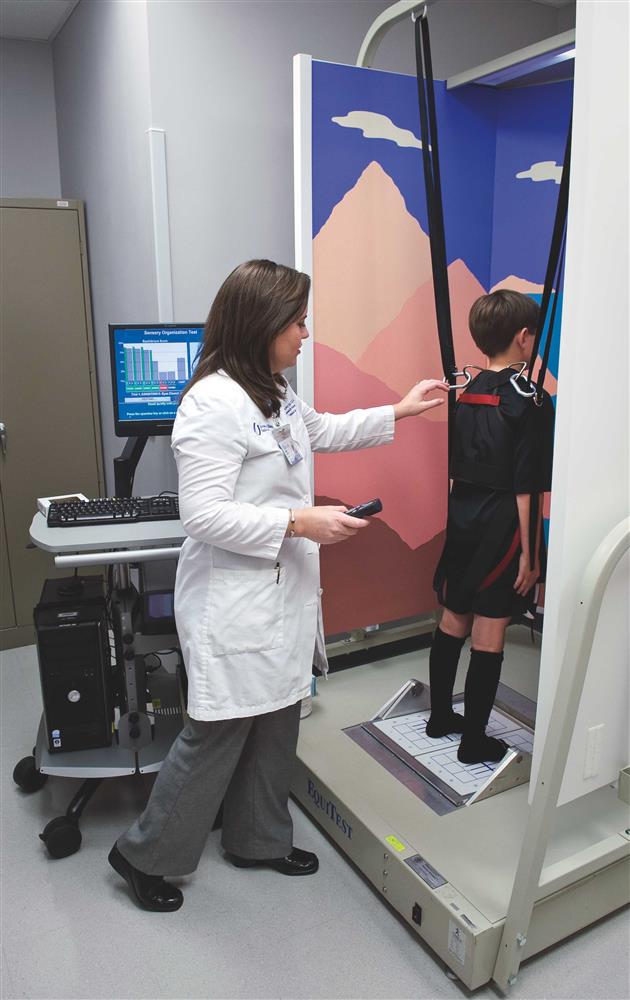UMMC lab offers new concussion test for young athletes

“Concussions are a hot topic,” said Dr. William Mustain, Ph.D. audiologist and the director of UMMC’s Vestibular Laboratory.
“This test will not only help determine if a concussion has occurred, but it can also … help answer the vital question: When is it safe for the athlete to play again?”
The lab’s staff recently learned of this new use for a piece of equipment already on hand: the Computerized Dynamic Posturography device, which features a large rectangular frame resembling a gutted refrigerator
In light of this new-found career for Posturography (“balance testing”), the lab has added it to ImPACT, the established piece of its concussion testing program, which measures memory, attention span, reaction time and more.
But it’s important to get young athletes and other concussion candidates to the lab and verify a baseline before an injury occurs, Mustain said.
This information would disclose what normal balance is for each individual, instead of relying on a standard range of normal – a critical distinction, particularly for athletes, whose sense of balance is likely to be above average.
Impaired balance or coordination is a sign of a concussion.
“If the same patient should suffer a blow to the head later, new tests would be compared to the baseline,” said Dr. Ian Windmill, Ph.D. audiologist and chief of the Division of Communicative Sciences.
The lab was already using Posturography to evaluate people who complain of dizziness, vertigo, imbalance, etc., because of disease, trauma, aging or other conditions.
Word of its new potential arrived at UMMC through an email to Dr. Denise Pouncey, Au.D. audiologist, from the manufacturer, NeuroCom, declaring that the NCAA endorsed its use for concussion testing.
Mustain researched the claim, contacted Dr. Ed Manning, Ph.D. clinical assistant professor of neurology, and together they and others formed a plan to swell Posturography’s repertoire.
The test is based on the knowledge that the body maintains balance through touch, vision and inner ear balance.
The muscles receive signals from those three systems; but for people with, say, vertigo, at least one of the systems is out of whack, Windmill said.
“Take people who get car sick. Usually this happens when they’re passengers in the back seat. Their eyes see the seat in front of them, which doesn’t move or change; so their vision says, ‘You’re not moving.’
“But the inner ear, which acts as a motion sensor, begs to differ. In some cases, the brain chooses one sense to believe, but “some brains don’t make the right choice,” Windmill said.
“So you throw up.”
Because a concussion affects either the brain functions or the inner ear, causing imbalance, Posturography is helpful in ferreting out the injury. Research shows that, for exposing inner ear disorders, it’s more accurate than clinical exams.
And some other, conventional tests, including CT scans, aren’t always reliable, Manning said.
Nor or they as lively. Inside the Posturography compartment, patients stand on a platform that gauges stability of stance and posture. They’re asked to close or open their eyes while the platform is either stable or moving – a sensation not unlike a small earthquake. Some lose their balance, but the harness keeps them from falling.
“All the patient has to do is try to maintain balance,” Windmill said.
The cost of the test is $120 per person. Insurance doesn’t cover it, but there’s a 20 percent group discount.
The staff of the Vestibular Lab wants to enlist parents, coaches, schools, booster clubs, physicians and others in the baseline-testing endeavor, especially in light of some disturbing studies.
“Research is raising concerns about the long-term lingering effects of a concussion on children – changes in behavior, decreased academic performance,” Manning said.
Another study, presented in October at the American Academy of Pediatrics National Conference and Exhibition, revealed that, during the past two years, 32 percent of high school football players surveyed did not report concussion-like symptoms, such as vomiting and headaches.
Released by Dr. Michael Israel of the University of Arkansas for Medical Sciences, the report showed that more than half of those athletes kept mum because they wanted to keep playing.
That attitude endures in spite of such recent high-profile concussion dramas involving NFL quarterback Robert Griffin III and NASCAR driver Dale Earnhardt Jr.
It endures in the face of awareness campaigns created by the National Football League and other pro sports organizations.
That awareness extends now to the entire Southeastern Conference, which is scrutinizing its own sports-related concussions through a committee that includes Mustain and Ole Miss Chancellor Dr. Dan Jones, who chairs it.


